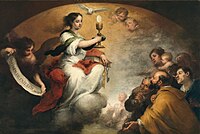
Back Pous Paulus III Afrikaans Paul III. ALS بولس الثالث Arabic بولس التالت ARZ Павел III Byelorussian Павал III (папа рымскі) BE-X-OLD Павел III Bulgarian Paol III Breton Pau III Catalan Gáu-huòng Paulus 3-sié CDO
Paul III | |
|---|---|
| Bishop of Rome | |
 | |
| Church | Catholic Church |
| Papacy began | 13 October 1534 |
| Papacy ended | 10 November 1549 |
| Predecessor | Clement VII |
| Successor | Julius III |
| Previous post(s) |
|
| Orders | |
| Ordination | 26 June 1519 |
| Consecration | 2 July 1519 by Leo X |
| Created cardinal | 20 September 1493 by Alexander VI |
| Personal details | |
| Born | Alessandro Farnese 29 February 1468 |
| Died | 10 November 1549 (aged 81) Rome, Papal States |
| Buried | St. Peter's Basilica |
| Partner | Silvia Ruffini (mistress) |
| Children | Pier Luigi II Farnese Paolo Farnese Ranuccio Farnese Costanza Farnese Lucrezia Farnese |
| Coat of arms |  |
| Other popes named Paul | |
| Papal styles of Pope Paul III | |
|---|---|
 | |
| Reference style | His Holiness |
| Spoken style | Your Holiness |
| Religious style | Holy Father |
| Posthumous style | None |
| Part of a series on |
| Catholic Counter-Reformation |
|---|
 |
| Catholic Reformation and Revival |
Pope Paul III (Latin: Paulus III; Italian: Paolo III; 29 February 1468 – 10 November 1549), born Alessandro Farnese, was head of the Catholic Church and ruler of the Papal States from 13 October 1534 to his death, in November 1549.
He came to the papal throne in an era following the sack of Rome in 1527 and rife with uncertainties in the Catholic Church as the Protestant Reformation progressed. His pontificate initiated the Catholic Reformation with the Council of Trent in 1545, and witnessed wars of religion in which Emperor Charles V launched military campaigns against the Protestants in Germany. He recognized new Catholic religious orders and societies such as the Jesuits, the Barnabites, and the Congregation of the Oratory. His efforts were distracted by nepotism to advance the power and fortunes of his family, including his illegitimate son Pier Luigi Farnese.
Paul III was a significant patron of artists including Michelangelo, and it is to him that Nicolaus Copernicus dedicated his heliocentric treatise.